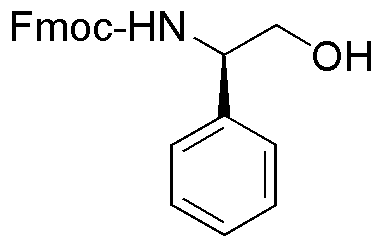Fmoc-D-phenylglycinol is widely utilized in research focused on
- Peptide Synthesis: This compound serves as a protecting group in the synthesis of peptides, enabling chemists to selectively modify amino acids without affecting others, which is crucial for creating complex proteins.
- Drug Development: It plays a role in the development of pharmaceuticals, particularly in the design of compounds that can interact effectively with biological targets, enhancing drug efficacy.
- Biotechnology: Used in the production of biologically active peptides, it helps in the creation of therapeutics for various diseases, including cancer and diabetes, by facilitating the development of targeted treatments.
- Research Applications: In academic and industrial laboratories, it is employed in studies related to protein folding and function, providing insights into molecular biology and biochemistry.
- Analytical Chemistry: This compound is also utilized in analytical techniques such as chromatography, where it aids in the separation and identification of complex mixtures, benefiting quality control processes.
General Information
Properties
Safety and Regulations
Applications
Fmoc-D-phenylglycinol is widely utilized in research focused on
- Peptide Synthesis: This compound serves as a protecting group in the synthesis of peptides, enabling chemists to selectively modify amino acids without affecting others, which is crucial for creating complex proteins.
- Drug Development: It plays a role in the development of pharmaceuticals, particularly in the design of compounds that can interact effectively with biological targets, enhancing drug efficacy.
- Biotechnology: Used in the production of biologically active peptides, it helps in the creation of therapeutics for various diseases, including cancer and diabetes, by facilitating the development of targeted treatments.
- Research Applications: In academic and industrial laboratories, it is employed in studies related to protein folding and function, providing insights into molecular biology and biochemistry.
- Analytical Chemistry: This compound is also utilized in analytical techniques such as chromatography, where it aids in the separation and identification of complex mixtures, benefiting quality control processes.
Documents
Safety Data Sheets (SDS)
The SDS provides comprehensive safety information on handling, storage, and disposal of the product.
Product Specification (PS)
The PS provides a comprehensive breakdown of the product’s properties, including chemical composition, physical state, purity, and storage requirements. It also details acceptable quality ranges and the product's intended applications.
Certificates of Analysis (COA)
Search for Certificates of Analysis (COA) by entering the products Lot Number. Lot and Batch Numbers can be found on a product’s label following the words ‘Lot’ or ‘Batch’.
Numéro de catalogue
Numéro de lot/série
Certificates Of Origin (COO)
This COO confirms the country where the product was manufactured, and also details the materials and components used in it and whether it is derived from natural, synthetic, or other specific sources. This certificate may be required for customs, trade, and regulatory compliance.
Numéro de catalogue
Numéro de lot/série
Safety Data Sheets (SDS)
The SDS provides comprehensive safety information on handling, storage, and disposal of the product.
DownloadProduct Specification (PS)
The PS provides a comprehensive breakdown of the product’s properties, including chemical composition, physical state, purity, and storage requirements. It also details acceptable quality ranges and the product's intended applications.
DownloadCertificates of Analysis (COA)
Search for Certificates of Analysis (COA) by entering the products Lot Number. Lot and Batch Numbers can be found on a product’s label following the words ‘Lot’ or ‘Batch’.
Numéro de catalogue
Numéro de lot/série
Certificates Of Origin (COO)
This COO confirms the country where the product was manufactured, and also details the materials and components used in it and whether it is derived from natural, synthetic, or other specific sources. This certificate may be required for customs, trade, and regulatory compliance.


